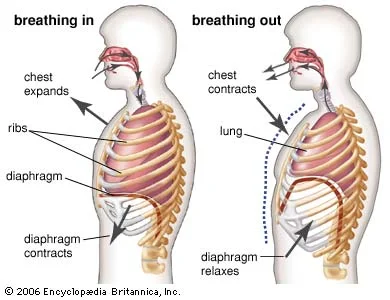When we come to the mat, we create an opportunity to be as mindful with our bodies and our minds. One of the essential components of the practice is linking breath with movement. Teachers often cue the breath by saying, “Use ujjayi breath,” “Inhale, open and expand the chest,” “Exhale, allow your navel to come down and into your spine.” But what are these cues really trying to get you to do? Mindful breathing not only calms and centers, it also strengthens the breath core awareness that puts our bodies into a neutral position, so that when we’re off our mats, we continue to feel grounded no matter where we are in life. One of the biggest muscles in the body, the diaphragm, is the dome shaped structure that separates the thoracic cavity from the abdomen. This muscle exists in the trunk of the body and is fully responsible for respiratory breathing. The diaphragm operates in both voluntary and involuntary ways. During inhalation, the diaphragm contracts and moves down and in, enlarging the volume of the thoracic cavity and the lungs above it. When this happens, our ribs expand, chest rises, and our pelvic floor rotates towards the back to allow the spine to extend to create space for the lungs to inflate. Mindful inhalation is the intentional action to engage the diaphragm, create more space in the trunk, and open up the lungs to full capacity resulting in a deep and full breath.
During exhalation, the diaphragm relaxes; air is exhaled by elastic recoil of the lungs and the tissues lining the thoracic cavity, which is called ZOA, zone of apposition. Every time we exhale, the zone between our diaphragm and our rib cage shrinks and folds in. Mindful exhalation involves repositioning the rib cage down and in, bringing the navel to the spine, contracting abdominal muscles, and engaging the pelvic floor to rise and expel air from the torso. Our mindfulness towards a full exhale allows the pelvic floor to rotate forward and open up as we force the air out of the lungs in exchange for fresh oxygen to the muscles and blood.
When we experience deep and mindful breath, we engage the diaphragm and core abdominal muscles and encourage the maximum amount of air flow into our lungs and oxygen into our bloodstream thus being able to be in full force in our muscular action. Mindful breathing brings attention to the strength necessary to maintain spinal stability: when we inhale our spine flexes, as we exhale our spine contracts. Maintaining aware of the relationship between our spine, our pelvic floor, and our diaphragm enhances the efficiency and effectiveness of all our bodily movements, especially breathing. If we’re going to move our arms or legs in any direction, it’s always more efficient to work off a stable spine with strong and coordinated breath.
The more spinal awareness and stability we have, the more we can progress — and the healthier our progress — in flexibility and strength of hips, shoulders, and spine, and capacity of oxygen to muscles, bones, and tissues. Beginning each day in neutral position with a nice, big calming breath creates a situation for the body to lessen the amount of stress it has both chemically and physiologically. The awareness to set the pelvis into the neutral position and engage breath core awareness brings a whole new level to yoga practice. Incorporating these intentions on the mat deepens connection of the body and mind through the breath.


